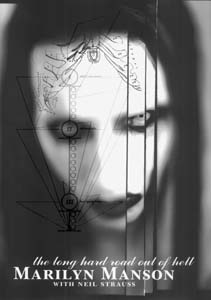Bookbeat
The Long Hard Road Out of Hell
By Sarah Quelland
EVER THE PARADOX, shock-rocker Marilyn Manson has become one of the most worshipped and most despised figures of the decade. With his band of the same name, Manson broke into the mainstream in 1994 with Portrait of an American Family, an album that lyrically bares some of society's ugliest skeletons. Since then, Manson's provocative, profane and, to some, obscene lyrics have sparked an acrimoniuos debate about the limits of artistic expression. Both because of, and despite, the controversy surrounding him, Manson has gained a legion of fans, from misfit teens to celebrities like Howard Stern.
Reading Manson's autobiography, The Long Hard Road Out of Hell, is like having a captivating one-sided conversation with a man who has left few taboos unbroken. Fans will devour the detail-drenched, illustrated text, while his religious-right opposition will discover new fuel for their fury.
Shock value permeates Manson's public existence, and his autobiography could have strayed down that path. Instead, Manson's candid prose offers a matter-of-fact retelling of the events that molded him into the misunderstood man he is today. The book's chronological structure parallels his most recent album, Antichrist Superstar, a musical recounting of his metaphorical transformation from a worm into an angel.
The Long Hard Road Out of Hell opens with Brian Warner (Manson's given name) in the worm stage. At age 13, Manson was living a sad existence in Canton, Ohio. His homelife was unsatisfying, and his family hid a very dark secret. He had only two real friends--his cousin Chad and his Alaskan malamute, Aleusha. He attended a God-fearing Christian school that made him miserable.
Struggling to make sense of life and form his identity, Manson began to seek answers and kindred spirits in the forbidden music of Kiss, Judas Priest and Black Sabbath. Fed up with parochial school, he enrolled in public school in 10th grade and moved to Fort Lauderdale, Fla., after graduation. There he embarked on the path that led him to stardom.
The reader experiences Manson's introductions to sex, drugs and occult dabblers, then watches the circumstances under which the band forms, from the early days (1989-1990) to the current lineup. When he is ordained a reverend in the Church of Satan by founder Anton LaVey in 1994, Manson seems almost giddy. But by 1996, he has flung himself into a cocaine-strewn abyss in New Orleans, and one can almost hear him hit bottom. He regains his equilibrium, however, and it's at the cusp of this rebirth that the text abruptly ends.
Manson's story can jolt even the biggest fan with jarring emotions, from pity, disgust and annoyance to envy and adoration. He brazenly opens the door to his world, as vile as it can be, without so much as sweeping the floor. But he does it gently, as if guiding the reader by the hand the whole way.
Onstage, Manson is a writhing demon; offstage, he's a soft-spoken philosopher who plumbs the depths of life for meaning. He's also a hedonist who denies himself little, and one of his greatest strengths is that he wants to be a star, a desire that his autobiography openly recognizes.
Though much of the story in The Long Hard Road Out of Hell has been told before in bits and pieces in various interviews, it's insightful to hear Manson tell it himself. He grants rare glimpses into his sense of humor and provides a better understanding of his humanity. This narrative is a must for fans of the wiry diva. Others with an open mind may also enjoy reading about Manson's believably unbelievable life.
[ San Jose | Metroactive Central | Archives ]
Copyright © Metro Publishing Inc. Maintained by Boulevards New Media.
![]()
 The Worm Turns: Marilyn Manson tells (with a little help from Neil Strauss) the story of his transformation from troubled teen to culture-wars whipping boy in 'The Long Hard Road out of Hell.'
The Worm Turns: Marilyn Manson tells (with a little help from Neil Strauss) the story of his transformation from troubled teen to culture-wars whipping boy in 'The Long Hard Road out of Hell.'
The Long Hard Road Out of Hell, by Marilyn Manson with Neil Strauss; Regan Books; 269 pages; $24 cloth.
From the April 2-8, 1998 issue of Metro.
![[Metroactive Books]](/books/gifs/books468.gif)